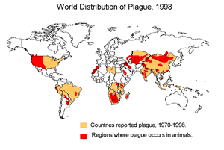Yersinia pestis infection epidemiology and demographics: Difference between revisions
No edit summary |
No edit summary |
||
| Line 1: | Line 1: | ||
__NOTOC__ | __NOTOC__ | ||
Please help WikiDoc by adding more content here. It's easy! Click [[Help:How_to_Edit_a_Page|here]] to learn about editing. | |||
{{Yersinia pestis infection}} | {{Yersinia pestis infection}} | ||
{{CMG}} | {{CMG}} | ||
| Line 19: | Line 21: | ||
[[Category:Disease]] | [[Category:Disease]] | ||
[[Category:needs overview]] | [[Category:needs overview]] | ||
[[Category:Needs content]] | |||
{{WikiDoc Help Menu}} | {{WikiDoc Help Menu}} | ||
{{WikiDoc Sources}} | {{WikiDoc Sources}} | ||
Revision as of 19:04, 18 December 2012
Please help WikiDoc by adding more content here. It's easy! Click here to learn about editing.
|
Yersinia pestis infection Microchapters |
|
Differentiating Yersinia Pestis Infection from other Diseases |
|---|
|
Diagnosis |
|
Treatment |
|
Case Studies |
|
Yersinia pestis infection epidemiology and demographics On the Web |
|
American Roentgen Ray Society Images of Yersinia pestis infection epidemiology and demographics |
|
FDA on Yersinia pestis infection epidemiology and demographics |
|
CDC on Yersinia pestis infection epidemiology and demographics |
|
Yersinia pestis infection epidemiology and demographics in the news |
|
Blogs on Yersinia pestis infection epidemiology and demographics |
|
Risk calculators and risk factors for Yersinia pestis infection epidemiology and demographics |
Editor-In-Chief: C. Michael Gibson, M.S., M.D. [1]
Epidemiology and Demographics
People usually get plague from being bitten by a rodent flea that is carrying the plague bacterium or by handling an infected animal.

Wild rodents in certain areas around the world are infected with plague. Outbreaks in people still occur in rural communities or in cities. They are usually associated with infected rats and rat fleas that live in the home. In the United States, the last urban plague epidemic occurred in Los Angeles in 1924-25. Since then, human plague in the United States has occurred as mostly scattered cases in rural areas (an average of 10 to 15 persons each year). Globally, the World Health Organization reports 1,000 to 3,000 cases of plague every year. In North America, plague is found in certain animals and their fleas from the Pacific Coast to the Great Plains, and from southwestern Canada to Mexico. Most human cases in the United States occur in two regions: 1) northern New Mexico, northern Arizona, and southern Colorado; and 2) California, southern Oregon, and far western Nevada. Plague also exists in Africa, Asia, and South America (see map).